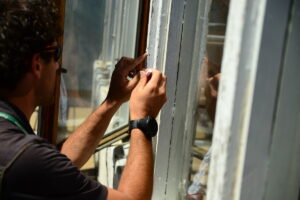Lead-based paint is no doubt a serious public health issue, especially in older buildings throughout New York City. Buildings constructed before 1960 are most at risk, as they are likely to contain lead-based paint that can deteriorate and pose severe health hazards. The City of New York has strict regulations around identifying, correcting, and certifying the removal of lead hazards, overseen by agencies like the Department of Housing Preservation and Development (HPD) and the Department of Health and Mental Hygiene (DOHMH).
Today, in this blog, we will be discussing the step-by-step guide to lead violation removal in NYC.
Step-by-Step Process for Removing Lead Violations in NYC
Step 1: Know the Type of Violation
The first step in resolving any lead violation is knowing what type of violation has been issued. Lead violations in NYC are generally categorized under three primary codes:
- Order #616: Presumed lead-based paint hazard, often cited when a building predates 1960 and deteriorated paint is present in areas accessible to young children.
- Order #617: Confirmed lead-based paint hazard, meaning laboratory testing has verified the presence of lead.
- Order #623: Turnover violation, which indicates that a landlord failed to inspect and remediate lead hazards during the turnover period between tenants.
The specific violation code determines the urgency, remediation strategy, and required documentation. Property owners must read the violation notice carefully to fully understand their legal obligations.
Step 2: Hire Certified Professionals
New York City mandates that only certified professionals may handle lead inspection and remediation work. This ensures safety and legal compliance.
- Lead Inspector/Risk Assessor: Hire an EPA-certified lead inspector to perform an initial inspection and risk assessment. This professional will test surfaces to confirm the presence and extent of lead-based paint hazards.
- Lead Abatement Contractor: If lead is confirmed, you must hire an EPA-certified lead abatement contractor. This contractor will follow stringent guidelines to safely remove or encapsulate the hazardous material.
Ensure that both professionals are licensed in accordance with EPA regulations and NYC Health Code §173.14. Always request and keep copies of their credentials for your records.
Step 3: Notify the Appropriate Agencies
Before any remediation work begins, you are legally required to notify the appropriate city agency. Submit a Notification of Commencement of Lead Abatement Work to HPD or DOHMH 1 to 3 business days prior to the scheduled start date.
Failing to notify the agencies could result in additional violations and penalties. The notification should include:
- The nature of the work to be performed
- Contractor information
- Estimated start and completion dates
This requirement helps the city track remediation efforts and ensure compliance with local and federal safety laws.
Step 4: Conduct Safe Remediation
Lead remediation is highly regulated due to the toxicity of the material. The certified abatement contractor will use a combination of removal and containment techniques depending on the severity and location of the hazard.
Key safety practices include:
- Sealing off work areas using plastic sheeting and negative pressure enclosures to prevent the spread of dust.
- Using HEPA-filtered vacuums and wet methods to suppress dust during paint removal.
- Avoiding banned practices like dry scraping, open flame burning, or using heat guns above 1100 degrees Fahrenheit.
Children and pregnant women must vacate the premises during the remediation process. Proper disposal of hazardous waste is also mandated under NYC regulations.
Step 5: Clearance Testing and Final Inspection
Once the abatement work is complete, an independent EPA-certified inspector (different from the remediation contractor) must conduct a clearance inspection. This includes:
- Visual inspection to ensure all work areas are clean and intact
- Dust wipe sampling on floors, windowsills, and window troughs
Samples are sent to an accredited laboratory for analysis. The property must meet specific lead dust threshold levels set by the EPA and NYC law.
Clearance results must be submitted to the relevant agency within five business days of completion. Without passing clearance, the lead violation cannot be officially dismissed.
Step 6: Compile and Submit Documentation
To finalize the process and remove the lead violation from city records, the property owner must compile and submit comprehensive documentation, including:
- Copies of initial and final inspection reports
- Clearance test laboratory results
- EPA certification details of contractors and inspectors
- Signed statement of work from the abatement contractor
- Completed HPD or DOHMH Dismissal Request Form
Incomplete or inaccurate submissions will delay the dismissal process. It’s important to double-check all paperwork before submission.
Step 7: Receive Official Dismissal
Once your documentation is reviewed and approved, the city will issue an official Notice of Violation Dismissal. This confirms that you have met all legal requirements and the violation is resolved. Retain this document permanently, as it may be needed during property transactions, refinancing, or future inspections.
Dismissal notices may be mailed or accessible via NYC Housing Connect and HPD’s online portal. Always verify online or call the agency to confirm the dismissal status.
Step 8: Maintain Ongoing Compliance
Even after successful lead violation removal, property owners are required to maintain compliance with NYC’s ongoing lead safety rules, including:
- Conducting annual inspections of lead paint conditions in units with children under six
- Distributing annual lead paint disclosure notices to tenants
- Performing lead inspections at unit turnover
Non-compliance with these requirements can result in new violations and legal actions. Landlords should maintain a lead compliance log and consult legal counsel or property managers to ensure they are meeting all ongoing responsibilities.
Step 9: Apply for Exemptions if Eligible
Property owners who have had their properties tested and certified as lead-free may apply for exemptions that relieve them from certain obligations under NYC’s Local Law 1 of 2004.
Types of exemptions include:
- Lead-Free Exemption: Issued if certified testing proves that no lead-based paint exists in the dwelling.
- Lead-Safe Exemption: Granted when proper interim controls are in place and the paint is maintained in good condition.
Applications for exemptions must include detailed lab results, inspector credentials, and additional forms available on the NYC HPD website.
Also Read: What Does an EPA Certified Lead Paint Inspector Do?
Need Help With Lead Violation Removal in NYC? Contact Manhattan Lead
Need help with lead violation removal in NYC? Manhattan Lead is your trusted partner for expert inspections, certified remediation, and full compliance with city regulations. Our experienced team ensures safe, efficient lead hazard removal and violation dismissal. Contact Manhattan Lead today for professional support.




